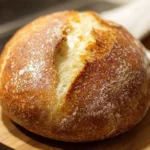Making sourdough bread is a rewarding experience, especially for beginners. This recipe not only teaches you the basics of bread-making but also introduces you to the joy of working with a sourdough starter. Sourdough has a rich, tangy flavor that comes from the natural fermentation process. It is healthier than store-bought bread because it uses natural ingredients and does not contain preservatives.
This recipe is perfect for anyone looking to improve their baking skills. You can take pride in creating something delicious from scratch. Plus, sourdough bread is incredibly versatile. You can enjoy it plain, as toast, or use it for sandwiches.
Homemade sourdough is also satisfying because you can share it with friends and family. The process may seem intimidating at first, but with practice, you’ll find it simple and enjoyable. Each loaf will be unique, reflecting your method and style. So, whether you’re a seasoned baker or trying out for the first time, learning to make sourdough bread at home is truly rewarding.
How to Make Sourdough Bread
To start, you need a sourdough starter, which is a mix of flour and water that has fermented with wild yeast and bacteria. If you don’t have one, you can create your own by mixing equal parts of flour and water and letting it sit for several days until bubbly.
First, measure out your sourdough starter, flour, water, and salt. Combine the starter and water in a large bowl, then add the flour and salt. Mix until there are no dry bits of flour left.
Now, let the dough rest for about 30 minutes. This allows the flour to absorb the water. After resting, knead the dough on a floured surface for about 10 minutes until it becomes smooth and elastic.
Place the kneaded dough in a bowl, cover it with a cloth, and let it rise for several hours or until it doubles in size. This could take anywhere from 4 to 12 hours, depending on the temperature and the strength of your starter.
Once risen, shape the dough into a round ball and let it rest again for about 30 minutes. Finally, place it in a preheated oven, bake for about 30-40 minutes, and enjoy the aroma of freshly baked sourdough bread!
How to Serve Sourdough Bread
Sourdough bread is wonderfully versatile and can be served in many delicious ways. One popular option is to enjoy it plain, either warm from the oven or toasted. The crusty exterior and chewy interior make for a delightful bite.
You can also spread butter, jam, or honey on slices of sourdough for a simple yet satisfying treat. This bread is great as toast for breakfast, topped with avocado, poached eggs, or even a sprinkle of salt and pepper.
For lunch or dinner, sourdough serves beautifully as a base for sandwiches. Fill it with your favorite ingredients such as turkey, cheese, and lots of fresh veggies. You can even use it for bruschetta, topped with tomatoes, basil, and a drizzle of olive oil.
Sourdough can also be a fantastic side to soups and salads. Its hearty texture can soak up broths perfectly, making it an ideal companion to any meal. With so many ways to enjoy sourdough bread, each meal can be a new experience!
How to Store Sourdough Bread
Storing sourdough bread correctly ensures it stays fresh and tasty. The best way to store your homemade sourdough is at room temperature. Place the bread in a paper bag or wrap it in a clean kitchen towel. This method prevents it from getting soggy while keeping the crust firm.
Avoid using plastic bags, as they trap moisture and can make the bread go stale more quickly. If you don’t plan to eat the bread within a few days, consider freezing it. Slice the bread before freezing for easy access.
To freeze, wrap the slices in plastic wrap and then in aluminum foil, or place them in a freezer-safe bag. This way, you can pull out just what you need without defrosting the whole loaf.
When you’re ready to enjoy it again, you can thaw the slices at room temperature or pop them in a toaster. For best flavor, try to consume your sourdough within a week if stored at room temperature, or a month if frozen.
Tips to Make Sourdough Bread
To ensure your sourdough turns out perfect, consider these helpful tips. First, use a kitchen scale to measure your ingredients accurately. This will give you better results in the texture and taste of your bread.
Second, pay attention to the temperature. Sourdough rises best in a warm environment. If your kitchen is cold, consider placing the dough in an oven with the light on or using a heating pad.
Third, be patient. Sourdough requires time to develop flavor, so don’t rush the fermentation and rising stages. If your dough isn’t rising as it should, it might need more time.
Fourth, practice shaping your dough. This can improve the final structure of your loaf. Lastly, make notes of your process for future baking sessions. Adjusting your method depending on climate or ingredient differences can lead to better results over time.
Variation
You can easily customize your sourdough bread with various add-ins. Try adding herbs like rosemary or thyme for a fragrant loaf. You can also mix in whole grains or seeds, such as sunflower seeds or flaxseeds, for added texture and nutrition.
If you prefer a touch of sweetness, consider adding dried fruits like raisins or cranberries, or even a bit of honey. Coconut flakes can add a tropical twist to your sourdough as well. Feel free to experiment with flavors that suit your taste!
FAQs
1. How long does it take to make sourdough bread?
It typically takes about 8 to 12 hours, factoring in the time for rising and fermenting the dough.
2. Can I use all-purpose flour instead of bread flour?
Yes, you can use all-purpose flour, but bread flour gives a better structure and texture.
3. Why is my sourdough bread dense?
A dense loaf can result from underproofing your dough or not having enough active sourdough starter. Be sure to allow it enough time to rise.
4. Can I bake sourdough bread without a Dutch oven?
Yes, you can bake it on a baking stone or a pizza stone. Just use steam during the first part of baking by placing water in a pan at the bottom of the oven.
5. How do I know when my sourdough bread is done baking?
It’s done when the crust is golden brown and sounds hollow when tapped on the bottom. Using a food thermometer, the internal temperature should reach around 200°F (93°C).

Homemade Sourdough Bread
- Total Time: 640 minutes
- Yield: 1 loaf 1x
- Diet: Vegetarian
Description
Learn how to make delicious homemade sourdough bread from scratch with this beginner-friendly recipe. Enjoy the rich, tangy flavor of naturally fermented bread.
Ingredients
- 1 cup sourdough starter
- 3 cups bread flour
- 1 1/2 cups warm water
- 1 teaspoon salt
Instructions
- Combine the sourdough starter and warm water in a large bowl.
- Add the flour and salt; mix until no dry flour remains.
- Let the dough rest for 30 minutes.
- Knead the dough on a floured surface for about 10 minutes until smooth and elastic.
- Place the kneaded dough in a bowl, cover with a cloth, and let it rise until doubled in size, 4 to 12 hours.
- Shape the dough into a round ball and rest for another 30 minutes.
- Preheat the oven and bake for 30-40 minutes until golden brown.
Notes
For variations, consider adding herbs, seeds, or dried fruit to enhance flavor. Experiment with different add-ins to suit your taste!
- Prep Time: 60 minutes
- Cook Time: 40 minutes
- Category: Bread
- Method: Baking
- Cuisine: American
Nutrition
- Serving Size: 1 slice
- Calories: 200
- Sugar: 0.5g
- Sodium: 200mg
- Fat: 1g
- Saturated Fat: 0g
- Unsaturated Fat: 1g
- Trans Fat: 0g
- Carbohydrates: 40g
- Fiber: 2g
- Protein: 6g
- Cholesterol: 0mg
Keywords: sourdough, bread, homemade, baking, beginner

